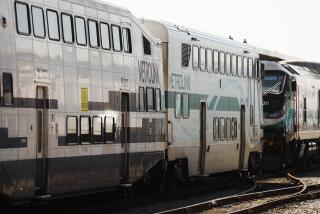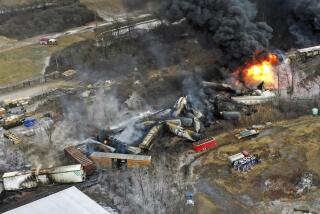Officials Warn of Danger on the Rails
Despite flashing lights, ringing bells, heavy gates, surveillance cameras and police patrols along the tracks, rail tragedies continue to occur. And since December, they have occurred with alarming frequency in Orange County, rail officials said.
Six people died during collisions with moving trains in the past seven months. During the entire year previously, two deaths occurred at local train tracks.
It’s unclear what has caused the increase in fatalities. But officials said it points up the need to develop new rail safety measures and provide better public education regarding the dangers posed by trains.
“They’re fast. They’re quiet. They’re deadly,” said Ed Pederson, manager of safety and security for Metrolink. “You get mixed up with one, and you don’t survive.”
While both freight and passenger trains are enjoying a resurgence in popularity, the number of rail fatalities in California has decreased over the last five years--thanks in part to added safety measures, Pederson said
But prompted by the jump in rail fatalities in Orange County, sheriff’s deputies have stepped up their patrols along the 47 miles of active rail tracks under the county’s jurisdiction. They have focused on stretches of track deemed particularly dangerous, such as the 4 1/2 miles along the beach at San Clemente.
This area was the site of two deaths earlier this year. In one case, a homeless man listening to a cassette tape on headphones was struck in January as he walked along a curve in the rail line.
“[The number of fatalities] runs in cycles,” Lt. Dan Jarvis said. “All of a sudden this year, we’ve seen an increase. . . . We’re trying to respond.”
Deputies issued more than 1,000 warnings and 200 citations to rail trespassers in 1998, and more than 15,000 warnings have been issued total since 1994, when patrolling of the tracks began. Yet pedestrians walking along and atop railroad tracks continue to be a pervasive problem.
On a typical day in San Clemente, for example, dozens of people can be spotted walking in the gravel alongside the tracks or on the tracks themselves.
*
“People think, ‘If a train’s coming, I’m going to hear it,’ ” Jarvis said. “Not necessarily. Rail beds are soft and gravelly. You won’t feel the vibrations. . . . The whistle is 17 feet in the air. The last thing you’ll feel is a push of air behind you.”
The San Clemente City Council rejected a plan earlier this year that would have placed a paved roadway for pedestrians alongside the tracks, with a fence between the tracks and the road. The plan met fierce opposition from residents who feared the fence would be a blight on their beach-front property.
In Santa Ana, Metrolink officials have installed, on a trial basis, a surveillance camera at the railroad crossing on Chestnut Avenue near Grand Avenue.
Motorists who gun their engines to beat the descending arm of a gate or make so-called “S” turns to drive around the gates when they are down in their locked positions are now caught on camera and fined $104.
From April 1 to May 15, 74 violations were caught on camera, with 24 people receiving citations. The rest could not be cited for various reasons.
Metrolink may consider expanding the camera surveillance if officials notice a significant decrease in violations at crossings where cameras are located, Pederson said.
Rail officials also are counting on the passage of a bill that is pending in the California Assembly that will increase the fine for a railroad crossing violation from $104 to $271.
Meanwhile, railroad engineers across the nation are at work on myriad safety schemes. In Connecticut, road sensors are being tested that detect when a vehicle is caught on railroad tracks and signal a locomotive more than a mile away. In Illinois, giant nets are being dropped in front of drivers when a train approaches.
In Los Angeles, the Metropolitan Transportation Authority is working on a four-gate system, a step up from the two gates more commonly found at crossings, designed to seal off the rail crossing and prevent drivers from weaving around the gates, for its Blue Line crossings.
Placentia is considering lowering the entire length of its busy Orangethorpe rail corridor below the level of the street for safety and traffic reasons.
But Pederson points out that the expense of many engineering solutions is often prohibitive. The preliminary cost of lowering the five-mile stretch along Orangethorpe Avenue has been estimated at about $275 million, for example.
A dose of common sense is the best insurance against tragedy, he said, pointing out that it takes a train traveling 79 mph nearly a half-mile to come to a halt, even with the emergency brakes on.
“The challenge is to educate the public and get the message across that trains are not toys,” he said.
(BEGIN TEXT OF INFOBOX / INFOGRAPHIC)
Safe at the Tracks
A train can weigh 17,000 times as much as an average car. When you get that much weight moving at even 30 mph, it won’t easily stop. So the safest place for you to be is out of its way. Most railroad fatalities take place at crossings, and the majority of those are equipped with warning devices.
* Always expect a train at crossings.
* Do not go around lowered crossing gates.
* Don’t drive onto a crossing unless you can get completely clear.
* If you stall on the tracks with a train coming, leave the car.
* Never race a train to a crossing.
* Because a train is big, it may appear to be moving slower than it is.
* Don’t walk or jog on tracks.
* Stay out of railroad tunnels and off trestles.
The Size Thing
By weight, a freight train is to your car as your car is to a can of soda.
Can of soda: 12 ounces
Average automobile: 3,000 pounds
Freight train: More than 12 million, as much as 50 million, pounds*
* Depending on number of engines/cars
Stopping Distances
Trains can’t stop quickly to avoid you. And MetroLink trains, because of their higher speed (track between Irvine and Santa Ana is rated for 90 mph), take about as much distance to stop as a freight hauler. How far it takes:
Average freight train
30 mph: 3,500 feet (2/3 mile)
50 mph: 8,000 feet (1-1/2 miles)
Eight-car passenger train
60 mph: 3,500 feet (2/3 mile)
79 mph: 6,000 feet (1-1/8 miles)
Warning Devices
* Means a crossing is ahead: use caution.
* Treat like a yield sign; sign below will indicate multiple tracks.
* Stop when lights start to flash, even if gate hasn’t lowered. Wait to cross until gate is raised and lights stop flashing.
* Always stay behind the stop line or at least 15 feet from the nearest rail.
* With multiple tracks, ensure there’s no train coming from other direction on a different track.
Most of Orange County’s 310 rail crossings are guarded by gates. Just two people have been killed during the last five years:
Crossing Guards
Gates: 58%
Crossbucks: 20
Flashing lights: 16
Other: 2
Nothing: 4
*--*
Deaths Injuries 1994 1 3 1995 0 7 1996 0 2 1997 0 6 1998 1 8
*--*
Sources: Federal Railroad Administration, MetroLink, Operation Lifesaver, Union Pacific Railroad
Graphics reporting by PAUL DUGINSKI / Los Angeles Times
More to Read
Sign up for Essential California
The most important California stories and recommendations in your inbox every morning.
You may occasionally receive promotional content from the Los Angeles Times.









